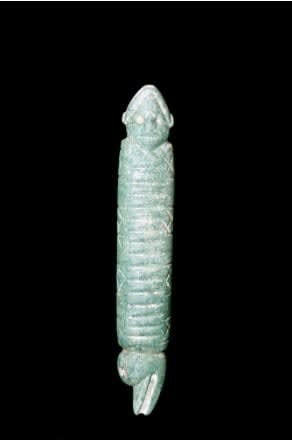Colima Stone Guiro Musical Instrument
Stone
7.5
MT.139
This beautifully carved and intriguing instrument (a guiro) was clearly a highly prized ritualistic possession would have been worn around the neck by the priest who would have played it....
This beautifully carved and intriguing instrument (a guiro) was clearly a highly prized ritualistic possession would have been worn around the neck by the priest who would have played it. Even after many centuries when a stick is run across it it plays an enthralling and compelling rhythm. Both the human face and the zoomorphic avian figure at the other imply and look like they are singing to the rhythm and tunes of the guiro.
Long before there were ceremonial rites with dancers and musicians in attendance, the earliest people of Mexico found ways to express themselves in sound and movement. It is probable that their first instruments were derived from seashells. Indeed the seashell probably served as a model for the guiro, still used by many Latin American orchestras today. The serrated spine of the shell and the hollow sounding chamber give off an interesting rhythmic staccato sound when scraped with a stick. As musical instruments became more complex they were integrated into processions and ceremonial rites. Dancing, which in the earliest days may have been confined to simple fertility rites, grew more complex as groups of dancers as well as individuals became part of the religious ritual.
In “A History of Ancient Mexico” Friar Bernardino de Sahagun (1499–1590) wrote that those who furnished the music for dancing were stationed within the ritual temple called Calpulco so that the dancers and musicians could not see each other. All the people of the palace, even the warriors danced in other parts of the courtyard holding each other by the hand and winding in and out and wriggling in snake fashion. Among these warriors one could also see maidens dancing, very well painted and their arms and legs adorned with red feathers. Dramatic processions of elaborately costumed participants, moving to music ensembles and playing sacred songs, passed through the ceremonial precinct before arriving at the specific temple of sacrifice. The most important of the priestly duties was the performance of rituals such as playing music at ceremonies.
Musicians served many ceremonial functions. Music also filled the celebratory halls of Bonampak, what is often referred to as The Temple of the Murals after victories of war. In the ancient murals of the Mayan city, musicians are depicted playing for the leaders of their city after a successful campaign. The Dresden Codex held in the Sächsische Landesbibliothek, the state library in Dresden, Germany, illustrates the spiritual link between music and the growth of corn in one particular section. In a display of skill and artisanship, the murals of Bonampak clearly illustrate that musicians, while servants of the city lords, were held in much higher regard than common townsfolk.
Music existed as a multi-faceted media, utilized anywhere from simple entertainment to intricate spiritual ceremonies. Its roots existed in the natural world and its essence extended to the super-natural. In all its totality, the intricate art form of this fascinating instrument sheds additional light on the complexity and sophistication of the ancient culture itself.
Long before there were ceremonial rites with dancers and musicians in attendance, the earliest people of Mexico found ways to express themselves in sound and movement. It is probable that their first instruments were derived from seashells. Indeed the seashell probably served as a model for the guiro, still used by many Latin American orchestras today. The serrated spine of the shell and the hollow sounding chamber give off an interesting rhythmic staccato sound when scraped with a stick. As musical instruments became more complex they were integrated into processions and ceremonial rites. Dancing, which in the earliest days may have been confined to simple fertility rites, grew more complex as groups of dancers as well as individuals became part of the religious ritual.
In “A History of Ancient Mexico” Friar Bernardino de Sahagun (1499–1590) wrote that those who furnished the music for dancing were stationed within the ritual temple called Calpulco so that the dancers and musicians could not see each other. All the people of the palace, even the warriors danced in other parts of the courtyard holding each other by the hand and winding in and out and wriggling in snake fashion. Among these warriors one could also see maidens dancing, very well painted and their arms and legs adorned with red feathers. Dramatic processions of elaborately costumed participants, moving to music ensembles and playing sacred songs, passed through the ceremonial precinct before arriving at the specific temple of sacrifice. The most important of the priestly duties was the performance of rituals such as playing music at ceremonies.
Musicians served many ceremonial functions. Music also filled the celebratory halls of Bonampak, what is often referred to as The Temple of the Murals after victories of war. In the ancient murals of the Mayan city, musicians are depicted playing for the leaders of their city after a successful campaign. The Dresden Codex held in the Sächsische Landesbibliothek, the state library in Dresden, Germany, illustrates the spiritual link between music and the growth of corn in one particular section. In a display of skill and artisanship, the murals of Bonampak clearly illustrate that musicians, while servants of the city lords, were held in much higher regard than common townsfolk.
Music existed as a multi-faceted media, utilized anywhere from simple entertainment to intricate spiritual ceremonies. Its roots existed in the natural world and its essence extended to the super-natural. In all its totality, the intricate art form of this fascinating instrument sheds additional light on the complexity and sophistication of the ancient culture itself.
